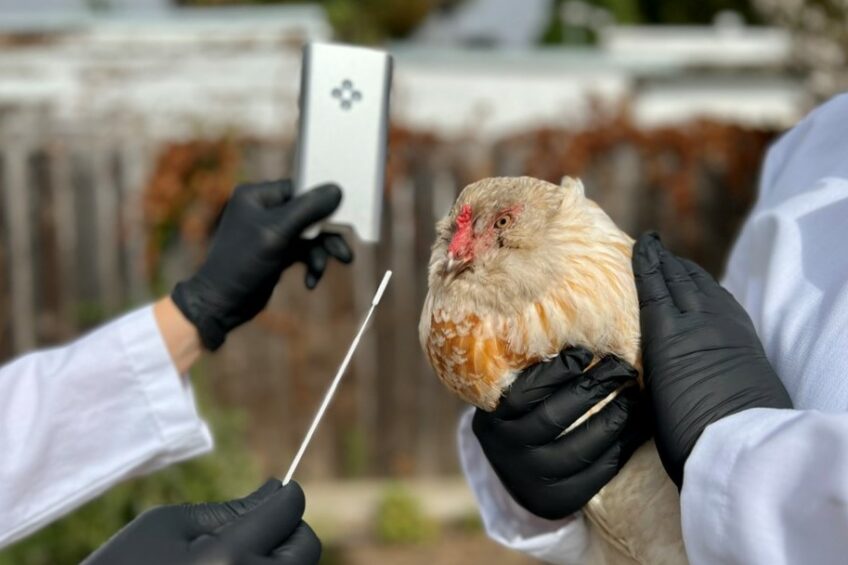Keeping on top of avian influenza with on-farm testing

Highly pathogenic avian influenza remains a concern to the global poultry sector. New infections are continually emerging in various parts of the world. For example, new outbreaks have recently occurred in Brazil.
With the European strain having travelled around the globe over in the past 2 years, avian influenza has also infected more than a dozen species of mammals, including racoons, cats, dogs, minks and foxes, and even dozens of sea lions died of highly pathogenic avian influenza in Argentina.
Poultry World reported on a new study that provided an analysis of emerging policy recommendations to control the disease, including recommendations that highlight the importance of taking a One Health approach to address disease risk. One Health is an integrated, unifying approach that aims to sustainably balance and optimise the health of people, animals and ecosystems.
Alveo Technologies, which makes rapid testing technology, claims that since 2003 there have been 240 known highly pathogenic avian influenza H5N1 infections in people. There is hope that the avian influenza vaccine trials now underway in the Netherlands will eventually lead to effective global protection against infection in commercial poultry flocks. Until then, decisions at farm level require testing – and the faster the tests, the better.
Test differences
Shaun Holt, CEO of Alveo Technologies, notes that testing for highly pathogenic avian influenza typically takes one of 2 forms: PCR or antigen. PCR technology is known for its accuracy, he says, but it requires sending samples to nationally-approved laboratories.
“It’s a DNA/RNA amplification method that requires repeated heating and cooling of the sample to specific temperatures and, therefore, is not a process that can be easily replicated in the field,” Holt notes. “Results can take days or even weeks to process depending on lab capacity, which delays on-farm decision-making, increases the risk of the infection spreading from one flock to another and extends human exposure time.”
Antigen tests, on the other hand, can typically be performed on-site. Although these tests produce results quickly, Holt says they are significantly less sensitive than molecular-based approaches, returning a significant number of false negative results. This means that manufacturers often require a second test 24-48 hours later. “This can also enable the virus to spread unimpeded and delay action that could stop or slow its spread,” says Holt.
The Alveo Technologies’ LAMP testing platform enables in-the-field testing that the company says is as accurate as PCR, with results in less than an hour. “Currently, we’re in late-stage testing… and expect to go to market in the first half of 2024,” says Holt, who reports a great deal of interest from companies in the poultry industry who wish to explore co-developing and distributing the test.
A closer look
LAMP stands for ‘loop‐mediated isothermal amplification’ and is an amplification method that does not require thermal cycling – heating up and cooling down the sample – like that of PCR. In addition, Holt explains that positive tests from the use of this technology “are time-stamped, geo-located and uploaded to the cloud which enables governments to accurately track the spread of bird flu and create databases to better understand the virus. As a result, officials can take swift action to stem the spread of the disease and create an informed strategy to combat it on a large scale.”
Holt adds that most LAMP-based tests commonly use an optical turbidity or fluorescence approach to detect the presence of the specific virus, bacteria or fungus in question. This method is susceptible to failure if the test is shaken, which can happen on the farm if people aren’t careful. Alveo, on the other hand, uses electrical methods of detection and, Holt says, “one can drop the test on the floor and it will still process the sample”.
Looking forward
You can expect the Alveo test to hit the market in the next 6 months. In the meantime, the vaccine trials in the Netherlands will continue. The trials will last until the third quarter of 2025 but the first results are expected to be published by spring 2024. A pilot on a larger number of poultry farms is expected to take place in the second quarter of 2024.
However, recently, Dr Monique Eloit, director general of the World Organisation for Animal Health (WOAH), expressed caution following its first Animal Health Forum, which focused on the current challenges and outlook for combatting avian influenza. Eloit said close cooperation and adherence to standards will help in the battle against bird flu, but there is no magic bullet that will stem the spread of the virus. Over 500 million birds have died of this disease since 2005. It remains a threat to livelihoods and food security.
The Poultry World Newsletter
Sign up for our newsletter and receive all our need-to-know content three times a week.
Join 31,000+ subscribers
Subscribe to our newsletter to stay updated about all the need-to-know content in the poultry sector, three times a week. Beheer
Beheer











 WP Admin
WP Admin  Bewerk bericht
Bewerk bericht